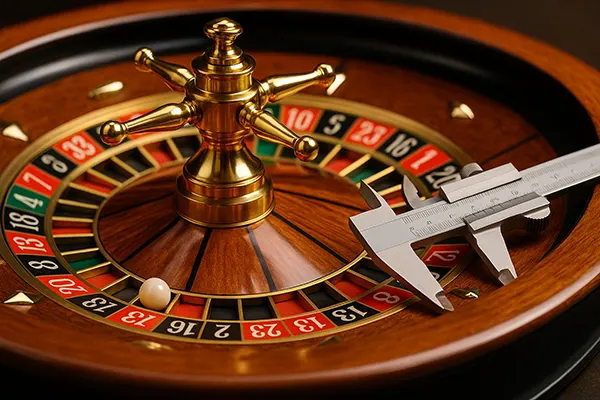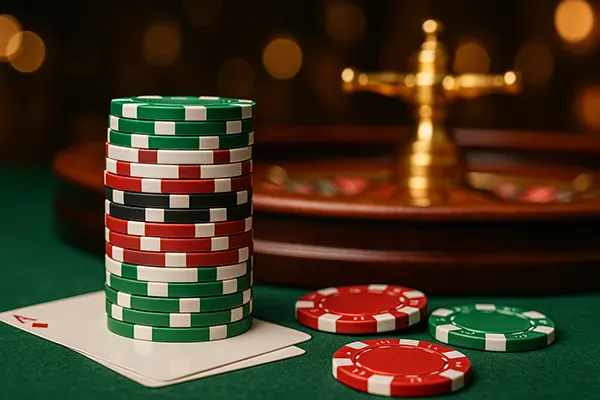Physical Features of the Roulette Wheel: Microscopic Analysis of Imbalance and Systemic Errors

The roulette wheel, often regarded as the symbol of fairness and randomness in casino gaming, is far from being a perfectly balanced object. In recent years, advanced optical measurements and microscopic evaluations have revealed that even the smallest imperfections in wheel design can influence the trajectory and final position of the ball. This analysis explores the physical nuances of roulette wheels, their manufacturing tolerances, and how minute irregularities can create measurable biases.
Precision Engineering and Design of Modern Roulette Wheels
Modern roulette wheels are manufactured under strict engineering standards to maintain fairness. Each component, from the frets separating the pockets to the ball track curvature, undergoes precision machining. Leading manufacturers such as Cammegh and TCSJohnHuxley use advanced CNC equipment and laser measurement systems to ensure each wheel meets industry specifications.
Despite these high standards, physical production can never achieve absolute perfection. Microscopic deviations of less than 0.05 millimetres in the wheel’s rim or uneven polishing of the pockets can cause the ball to bounce in a predictable manner. Over time, friction and material wear exacerbate these effects, creating what experts refer to as “systemic errors.”
Periodic calibration and maintenance help to mitigate these deviations, but even minor changes in humidity, temperature, or lubricant consistency can subtly alter the wheel’s dynamics. This makes continuous monitoring essential, especially in high-stakes environments where fairness must be beyond doubt.
Microscopic Deviations and Their Mathematical Impact
Researchers studying roulette wheel physics have applied microscopic imaging and slow-motion video analysis to measure how tiny imperfections affect ball motion. These studies have shown that imbalances as small as 0.02 millimetres can shift the probability distribution in favour of certain sectors. Although such effects are minimal in single spins, they become statistically relevant over thousands of trials.
Mathematicians and engineers model these deviations using Monte Carlo simulations to identify long-term trends. A wheel with a slightly raised fret or uneven surface coating may show bias toward neighbouring numbers, enabling skilled observers to detect patterns. This phenomenon has given rise to the controversial practice of “wheel clocking,” where players exploit these micro-imperfections.
Casino regulators now require periodic certification of wheel balance, using laser-based levelling systems and digital accelerometers. By 2025, most leading establishments have adopted automated balance verification systems that log real-time deviations and generate maintenance alerts before measurable bias develops.
Systemic Errors and Wear in Real Casino Conditions
In live casino environments, roulette wheels operate continuously, often for thousands of spins per day. Constant mechanical stress, vibration, and air resistance contribute to gradual wear. Even a slightly unbalanced rotor or worn ball track can generate systemic drift, affecting the random distribution of outcomes over time.
Systemic errors differ from random fluctuations because they persist and can be replicated. For instance, repeated use of metallic balls of inconsistent density may erode specific areas of the track, forming microgrooves. These grooves act as “memory zones,” where the ball’s deceleration follows a predictable pattern, subtly influencing results.
Routine inspections using electronic micrometers and high-resolution surface scanners are standard practice today. Certified technicians evaluate wheel symmetry, fret integrity, and spindle resistance. If detected, deviations beyond tolerance thresholds trigger recalibration or component replacement to restore mechanical neutrality.
Material Fatigue and Environmental Influence
Beyond physical wear, environmental factors play a critical role in wheel performance. Changes in air pressure, temperature, and humidity can alter material density and friction coefficients. For instance, brass frets expand slightly under heat, while wooden bases may contract with dry air, producing uneven rotations.
To counteract this, manufacturers now employ composite materials resistant to thermal and moisture variations. Modern wheels often integrate carbon-fibre composites and anti-static coatings that preserve surface consistency. This reduces cumulative bias caused by environmental changes, enhancing the reliability of long-term operation.
Advanced casinos are implementing controlled climate environments around roulette tables, maintaining steady humidity and temperature. By stabilising external conditions, operators can ensure that wheel dynamics remain consistent, sustaining both fairness and the integrity of gameplay.

Technological Monitoring and Bias Detection in 2025
By 2025, technology has transformed how roulette wheels are monitored. Artificial intelligence now assists engineers in real-time detection of imbalance through continuous sensor feedback. These systems analyse spin velocity, deceleration, and landing zones, identifying anomalies that could indicate structural bias or component fatigue.
AI-driven analysis allows for predictive maintenance — detecting mechanical irregularities before they impact outcomes. Data collected from thousands of spins are aggregated and cross-referenced against expected probability distributions. When deviations exceed defined limits, the system alerts operators for inspection and recalibration.
This technology not only safeguards fairness but also strengthens player confidence. With transparent data reporting and third-party certification, casinos demonstrate commitment to integrity, ensuring that the game remains governed by true randomness rather than mechanical imperfection.
Future Research and Engineering Perspectives
Future research in roulette wheel dynamics will likely focus on adaptive self-calibration systems. These innovations could automatically balance the wheel using internal micro-adjustments, eliminating human error in setup. Such systems may also employ nanomaterial coatings to minimise frictional wear and preserve geometric precision.
Physicists continue to explore fluid dynamics and motion simulation at microscopic scales, offering deeper insights into the behaviour of rolling spheres on imperfect surfaces. This research extends beyond gaming, influencing industries such as precision engineering and aerospace mechanics.
Ultimately, understanding the physical properties of roulette wheels bridges science and probability. As manufacturing evolves and technology enhances measurement precision, the timeless allure of roulette remains grounded in the delicate balance between chance and engineering perfection.
